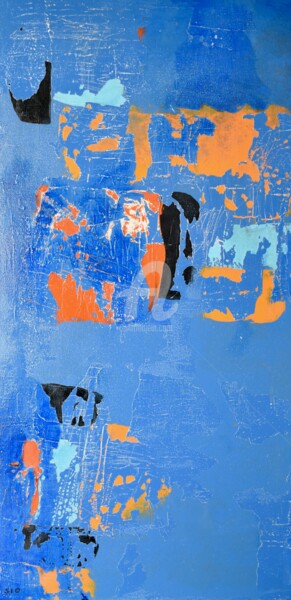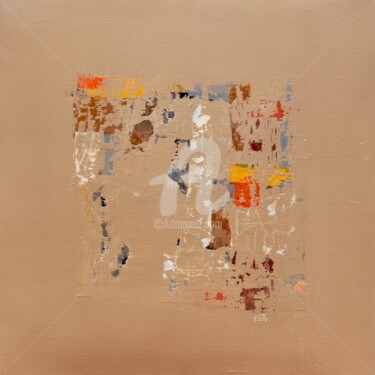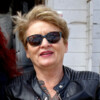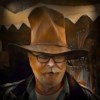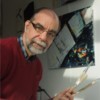Sio Montera
Dennis (Sio) Montera
29 Amihan St. Gentle Breeze
Subdivision, Cebu City, 6000
b.1972/ 08/19
PHILIPPINES
Home: +6332-3469885
Mobile: +639173295626
Email:
Education
University of the Philippines
Master of Fine Arts (MFA)
Diliman, Quezon City, NCR
Major: Studio Arts/ Painting
University of the Philippines
Bachelor of Fine Arts (BFA)
Cebu City
Major: Fine Arts/Painting
University of the Philippines
High School, Cebu City
Current Affiliation
University of the Philippines in the Visayas Cebu College
Gorordo Avenue, Lahug, Cebu City, PHL
June 1999 – Present
Current Rank and Positions in the University
• Assistant Professor 6
• Program Coordinator, Fine Arts Painting and Studio Arts Program
• Coordinator, U.P. Cebu Alumni Relations Office
• Member of the Board of Trustees, University of the Philippines Alumni Association Cebu Chapter Foundation, Inc. (UPAACCFI)
• President, University of the Philippines High School in Cebu - Alumni Association
• Member, Arts and Culture Committee, 1999-2002, 2004-Present
• Senior Adviser, Fine Arts Students Organization, 2005-Present
Professional Artists Group Affiliations
• Ex-Officio, Pusod, Inc. (The Open Organization of Cebu Visual Artists Inc.)
• Founding Member, Tuslob-Buwa Ltd., Artists Group
• Member, Visayas Islands Visual Artists Association (VIVAA)
Community Extension Services and Awards
• Juror, Float Category, 7th Garbo Sa Lapu-Lapu Festival, Lapu-Lapu City, Mactan, Cebu, November 18, 2007
• Ramon Durano Professorial Chair Award, University of the Philippines in the Visayas, December
2006-2007
• Semi-Finalist, Philippine Art Awards 2000, Sponsored by the Philip Morris Group of Companies,
Metropolitan Museum, Pasay City, November 2000
• Juror, PLDT and the Directories Philippines Corporation Visual Arts Competition, UPVCC, Lahug,
Cebu City, January 16, 2007
• Judge, Bughaw Arts Club Painting Competition, PAREF Springdale Arts Club, Lahug Cebu City,
February 24, 2007
• Juror, Sinulog Foundation Photo Competition, 2002
• Juror, PLDT and the Directories Philippines Corporation Visual Arts Competition, UPVCC, Lahug,
Cebu City, January 13, 2006
• Judge, Science and Technology Poster Making Contest, UPVCC Professional Education Division,
February 23, 2007
• Workshop Coordinator and Senior Facilitator (1998-Present) Annual Summer Art School, SM
City Cebu
• Design Consultant (2005-2006), Maitland-Smith Furniture Industries Inc., MEPZ, Lapu-lapu
City, Cebu
• Proponent, The Jose T. Joya Awards 1977-2006: Cataloguing the UPVCC Art Collection
• Founding Member, Tuslob-Buwa Artists Group, December 2005
• Chairperson (1999-2002), Pusod, Inc. (The Open Organization of Cebu Visual Artists)
• Grand Prize, Jose T. Joya Awards, Non-Objective Category, U.P. Cebu College 1993
• Grand Prize, Jose T. Joya Awards, Non-Obj...
Discover contemporary artworks by Sio Montera, browse recent artworks and buy online. Categories: contemporary filipino artists. Artistic domains: Painting, Photography. Account type: Artist , member since 2006 (Country of origin Philippines). Buy Sio Montera's latest works on ArtMajeur: Discover great art by contemporary artist Sio Montera. Browse artworks, buy original art or high end prints.
Artist Value, Biography, Artist's studio:
Third Quarter 2020 • 10 artworks
View allSio Montera
Acrylic on Canvas | 48x48 in
Sio Montera
Acrylic on Canvas | 60x60 in
Sio Montera
Acrylic on Canvas | 48x72.1 in
Second Quarter 2020 • 36 artworks
View allSio Montera
Acrylic on Canvas | 24x18.3 in
Sio Montera
Acrylic on Canvas | 24x18.3 in
Sio Montera
Acrylic on Canvas | 24x18.3 in
Sio Montera
Acrylic on Canvas | 24x18.3 in
Sio Montera
Acrylic on Canvas | 24x18.3 in
Sio Montera
Acrylic on Canvas | 24x18.3 in
Sio Montera
Acrylic on Canvas | 24x18.3 in
Sio Montera
Acrylic on Canvas | 24x18.3 in
Sio Montera
Acrylic on Canvas | 24x18.3 in
Sio Montera
Acrylic on Canvas | 24x18.3 in
Sio Montera
Acrylic on Canvas | 24x18.3 in
Sio Montera
Acrylic on Canvas | 24x18.3 in
First Quarter 2020 • 16 artworks
View allSio Montera
Acrylic on Canvas | 48x72.1 in
Sio Montera
Acrylic on Canvas | 48x72.1 in
Sio Montera
Acrylic on Canvas | 48x48 in
Sio Montera
Acrylic on Canvas | 30.1x24 in
Sio Montera
Acrylic on Canvas | 30.1x24 in
Sio Montera
Acrylic on Canvas | 30.1x24 in
Sio Montera
Acrylic on Canvas | 30.1x24 in
Sio Montera
Acrylic on Canvas | 30.1x24 in
Sio Montera
Acrylic on Canvas | 30.1x24 in
Sio Montera
Acrylic on Canvas | 48x36 in
Sio Montera
Acrylic on Canvas | 30.1x24 in
Sio Montera
Acrylic on Canvas | 30.1x24 in
Last Quarter 2019 • 12 artworks
View allSio Montera
Acrylic on Canvas | 76.8x76.8 in
Sio Montera
Acrylic on Canvas | 36x24 in
Sio Montera
Acrylic on Canvas | 36x24 in
Sio Montera
Acrylic on Canvas | 48x96 in
Sio Montera
Acrylic on Canvas | 48x96 in
Sio Montera
Acrylic on Canvas | 71.7x48 in
Sio Montera
Acrylic on Canvas | 71.7x48 in
Sio Montera
Acrylic on Canvas | 36x24 in
Sio Montera
Acrylic on Canvas | 48x48 in
Sio Montera
Acrylic on Canvas | 78.5x78.5 in
Sio Montera
Acrylic on Canvas | 28.5x24 in
Sio Montera
Acrylic on Canvas | 25.6x17.3 in
Second Quarter 2019 • 16 artworks
View allFirst Quarter 2019 • 9 artworks
View allSio Montera
Acrylic on Canvas | 48x48 in
Sio Montera
Acrylic on Canvas | 47.8x36 in
Sio Montera
Acrylic on Canvas | 48x36 in
Third Quarter 2018 • 12 artworks
View all2nd Quarter 2018 • 24 artworks
View allSio Montera
Acrylic on Canvas | 40x30 in
Sio Montera
Acrylic on Canvas | 28.5x20.9 in
Oxidation Series 2018-20 • 4 artworks
View allSio Montera
Acrylic on Canvas | 10.2x42.9 in
Sio Montera
Acrylic on Canvas | 12x36 in
Last Quarter 2017 • 15 artworks
View allSold by Tuslob-Buwa Artists Group • 35 artworks
View allSold Artworks • 590 artworks
Recognition
The artist has won prizes and awards
The artist's works have been noticed by the editorial staff
The artist participates in art shows and fairs
Biography
Dennis (Sio) Montera
29 Amihan St. Gentle Breeze
Subdivision, Cebu City, 6000
b.1972/ 08/19
PHILIPPINES
Home: +6332-3469885
Mobile: +639173295626
Email:
Education
University of the Philippines
Master of Fine Arts (MFA)
Diliman, Quezon City, NCR
Major: Studio Arts/ Painting
University of the Philippines
Bachelor of Fine Arts (BFA)
Cebu City
Major: Fine Arts/Painting
University of the Philippines
High School, Cebu City
Current Affiliation
University of the Philippines in the Visayas Cebu College
Gorordo Avenue, Lahug, Cebu City, PHL
June 1999 – Present
Current Rank and Positions in the University
• Assistant Professor 6
• Program Coordinator, Fine Arts Painting and Studio Arts Program
• Coordinator, U.P. Cebu Alumni Relations Office
• Member of the Board of Trustees, University of the Philippines Alumni Association Cebu Chapter Foundation, Inc. (UPAACCFI)
• President, University of the Philippines High School in Cebu - Alumni Association
• Member, Arts and Culture Committee, 1999-2002, 2004-Present
• Senior Adviser, Fine Arts Students Organization, 2005-Present
Professional Artists Group Affiliations
• Ex-Officio, Pusod, Inc. (The Open Organization of Cebu Visual Artists Inc.)
• Founding Member, Tuslob-Buwa Ltd., Artists Group
• Member, Visayas Islands Visual Artists Association (VIVAA)
Community Extension Services and Awards
• Juror, Float Category, 7th Garbo Sa Lapu-Lapu Festival, Lapu-Lapu City, Mactan, Cebu, November 18, 2007
• Ramon Durano Professorial Chair Award, University of the Philippines in the Visayas, December
2006-2007
• Semi-Finalist, Philippine Art Awards 2000, Sponsored by the Philip Morris Group of Companies,
Metropolitan Museum, Pasay City, November 2000
• Juror, PLDT and the Directories Philippines Corporation Visual Arts Competition, UPVCC, Lahug,
Cebu City, January 16, 2007
• Judge, Bughaw Arts Club Painting Competition, PAREF Springdale Arts Club, Lahug Cebu City,
February 24, 2007
• Juror, Sinulog Foundation Photo Competition, 2002
• Juror, PLDT and the Directories Philippines Corporation Visual Arts Competition, UPVCC, Lahug,
Cebu City, January 13, 2006
• Judge, Science and Technology Poster Making Contest, UPVCC Professional Education Division,
February 23, 2007
• Workshop Coordinator and Senior Facilitator (1998-Present) Annual Summer Art School, SM
City Cebu
• Design Consultant (2005-2006), Maitland-Smith Furniture Industries Inc., MEPZ, Lapu-lapu
City, Cebu
• Proponent, The Jose T. Joya Awards 1977-2006: Cataloguing the UPVCC Art Collection
• Founding Member, Tuslob-Buwa Artists Group, December 2005
• Chairperson (1999-2002), Pusod, Inc. (The Open Organization of Cebu Visual Artists)
• Grand Prize, Jose T. Joya Awards, Non-Objective Category, U.P. Cebu College 1993
• Grand Prize, Jose T. Joya Awards, Non-Obj...
-
Nationality:
PHILIPPINES

- Date of birth : 1972
- Artistic domains:
- Groups: Contemporary Filipino Artists
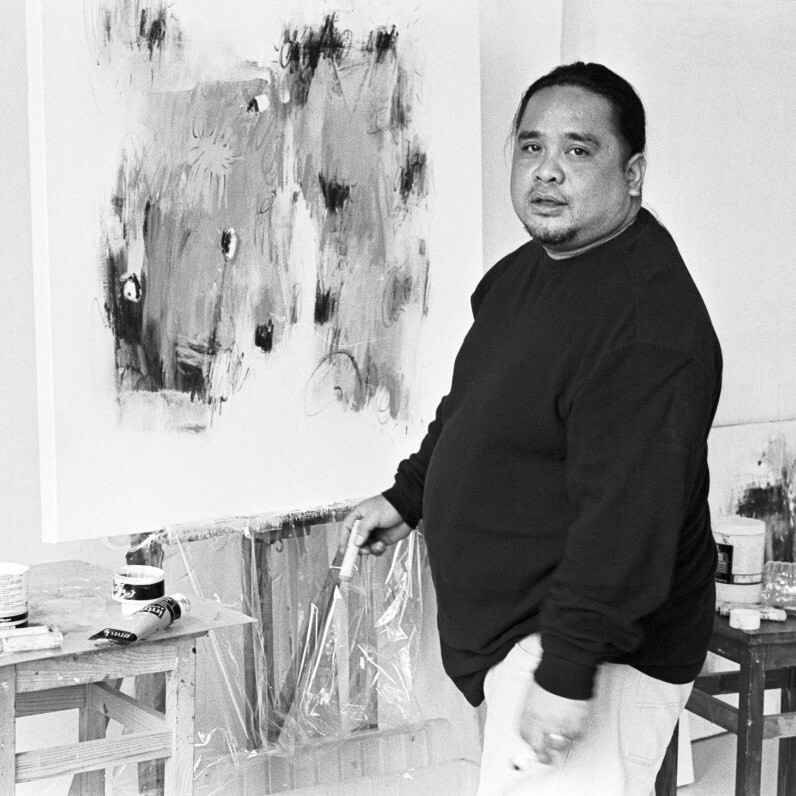
Ongoing and Upcoming art events
Influences
Education
Artist value certified
Galleries & Groups
Presented by Tuslob-Buwa Artists Group
 Tuslob-Buwa Artists Group
(Artist Collective, Philippines)
Tuslob-Buwa Artists Group
(Artist Collective, Philippines)Achievements
Prizes and Awards
Collective Expositions
Residencies
Solo Expositions
Activity on ArtMajeur
Latest News
All the latest news from contemporary artist Sio Montera
SakripiSIO
Art Center, 4th Level SM Megamall, Mandaluyong City, Philippines
Cebu-based abstractionist Dennis “Sio” Montera, confronts his fears as part of the process in evoking a total experience in achieving a rejuvenated aesthetic harmony through his current series and exhibition titled SakripiSIO. The artist’s works constantly focus on his ability to use biographical and deeply personal experiences as source material for his remarkably consistent—abstracts.
In this new collection, Montera focuses on the uniquely Filipino understanding of sacrifice as both an interpretative process, as well as a total concept that connects the individual, society, and material existence together into a logical and absolute experience.
The artist takes into account his recent struggles to balance social responsibility and personal fulfilment, anger and pain through the degree of gestural expression in most of the works while the other pieces signify the beginning of acceptance and the willingness to move on, suggesting the path towards enlightenment. Sio Montera SakrispiSIO will show us why there is a need to defy the inevitability of death, betrayal, and destruction, and how to assess the remaining time that we have.
The artist is currently the Vice-Head of the Committee on Visual Arts of the NCCA and a member of the UP-Cebu Fine Arts faculty. He received the grand prize in the abstract category of the 2010 GSIS Painting Competition. The exhibit opens at the Art Center of SM Megamall on June 17, 2011 and is part of Renaissance Gallery’s eigth anniversary presentation. For deatails, contact 632-6373101.

Abstracsion 2
Bluewater Gallery, Maribago Bluewater Beach Resort, Mactan, Cebu
Academic training has exposed Dennis ‘Sio’ Montera, initially, in creating realist-inspired nature visual artworks before he finally found his own illustrative language.
On his fifth-year as an artist, he came back to Cebu City armed with a Masters degree in painting earned from University of the Philippines. Sio mounted two important solo exhibitions on abstract art at the Art Center of SM City Cebu and Bluewater Gallery of Maribago Bluewater Beach Resort. These shows received accolade from critics and collectors, alike, and brought to the community a fresh take on serious visual art. That two special occasions baptized Sio as one of the few visual artists who have taken the road less travelled – the exploration of the non-objective realm in mainstream art.
Sio, as his intimates call him, takes inspiration from the likes of Franz Kline, Robert Motherwell, Jackson Pollock, Jean Dubuffet, Cy Twombly, Jean Michel Basquiat and Antoni Tapies. He admits that Philippine artists like Nestor Vinluan, Lao Lianben, and Jose Joya joins the list of artists that stirred him to undertake a personal experiment materials, tools and effects.
Sio Montera began to mix industrial materials with the conventional artist’s paints. After hundreds of hours of test and trials he succeeded in integrating diverse resources into a convincing overall composition. His canvasses are condensed into massive, encrusted color-filled paintings of either gestural lines or scratched surfaces. The lines created in his gestural works often resemble coagulated ink blots that glide from one corner to the other with total abandon and freedom. The scratched/scraped picture plane is the most recent reinvention of the artist’s style and the indentations on the surface of the paintings function like individual graffiti, the artist set of personal coded references inscribed on the work’s ground like hardened symbols or signs.
In this latest exhibition dubbed “AbstracSIOn II” which opens to the public on August 14, the artist metaphorically combines artistic production with immediate experiences of his human existence. Each of the works creates an overall effect that is based from the language of the artist’s soul and is considered by him as emblems and symbolic indications of his presence in this short life. These new installment of Sio Montera’s work has also taken distance from the linear logic of adults to arrive at the impulsive logic of children. The created visual field reassures flatness that is both direct and embracing typical of the spontaneity inherent in the spur-of-the-moment, scribble drawings. They represent for him an extraordinary mirror for multiplying or shattering imagery to reinvent or exorcize life.
Bluewater Gallery will feature Dennis “Sio” Montera’s exhibit from August 14 to September 30, 2009. For exhibit viewing appointment, get in touch with Gallery Coordinator Ruben B. Licera, Jr. at (63 32) 492 0100 local 512 or email .

Aftermath
Renaissance Gallery, Artwalk, 4th Level, SM Megamall Bldg. A
Sio Montera unveils his latest collection of abstract expressionist inspired artworks at the Renaissance Gallery, SM Megamall, Mandaluyong City, Philippines. This is the artist's second solo exposition for the year and his tenth overall. The exhibit will run from October 2-11, 2009. For information on the works in the gallery, please call 632-6373101 or email .

Art Diocese (Why Art Thou)
Art Center, SM City Cebu, Philippines
We say amen to affirm our faithfulness. The creative process is a prayer that intellectually stimulates the hunger to create art. The true artist is a spiritual; art to him is imbued with spirituality. A real artist fights for what he believes in and is willing to die for his beliefs like the crusader of the past. And artist fights because he is committed and die because he is dedicated. As the last major group exhibition for the year 2007, Tuslob-Buwa Ltd. will present another unprecedented leap where art has not gone before. The art group composed of namely Evan Bejec, Sio Montera, Jojo Sagayno, and Ritchie Quijano, are all in search of new concepts to push their art-making to new and higher levels of awareness. ART DIOCESE subtitled “Why art thou!” explores the realm of the sacred. The exhibit is not intended to make pun to the authority of the archdiocese. It however tries to reinforce faith by strengthening the visual form of articles and facts relevant to religion. The concept-themed show will be tackling the issue of continuity of the visual arts of the church and faith in the face of modernism and contemporary art.
We the artists believes the church as an institution of faith will see a change of form and design as it enters a new era. The changes that are currently happening have challenged the artists to contribute new and dynamic ideas using elements of church and articles of faith to the body of knowledge that is visual arts history. ART DIOCESE is intended to be a courageous breach to broaden the limits of the artistic license and as a revolutionary attempt to stage a revisionist show that re-imagines and re-engineers the exoticism of faith thru visual art forms. Religious in tone and nature Tuslob-Buwa artists made incursions into church state, history and religious culture then endorses a contemporary form to religious imagery by formulating non-literal and pictorial representations. Revisioning to a point where the artists investigated its old traditions to come up with conceptual forms attuned to the post-modern times. The investigations led to research on the divine and inquiries on how the church have transformed over the centuries and how it can transform in the centuries to come by looking ahead in a prophetic and visionary way. The exhibit is as well intended to preempt the evolution to see what is there to come from its old-world appearance into a church of the new age all in the name of art. These are varied propositions of how the church and faith can be viewed and a peek into its transformation. The artists as instruments who are endowed with that godly gift of creativity, intellect, and potent power takes the role as artificers of the Supreme Being and in many ways faces their ultimate experience as men in understanding and seeing God or its representatives, representations, and symbolisms.
As a concept show the artists are one in utilizing the modern cultural trend of adaptive reuse of materials. By selecting those that is familiar with indigenous culture, native and endemic to the artist’s direct environment. Much of these materials that are used are consistent to the methods of the old-world construction practice. The art works are in the format of paintings, installations, and sculptures. Adaptive reuse in art refers to the reprocessing of known materials into a creative and indigenous product. It is a kind of finding new use to an old piece to renew and extend the life of the material. Here we prolong the materials usage and life into art works. Conversion is central to the art making process. Though more than just extending the shelf-life and use of a particular material, the artists have gifted it with immortality, aesthetics, and as objects of value and cultural significance. A selected material undergoes creative conversion in the hands of the artists. The variety of materials that is included in this exposition all show the transformation from raw to finish product. There is a collective/collaborative work that makes use of fibrous and organic rattan skin and abaca that is wall-mounted to stimulate pillars and native religious structures and figures. Individual works are the latest and most recent collections of each artist’s incursion into the divine nature and will. ART DIOCESE is an adoration of faith and a revelation the artist have reveled and most importantly an epiphany that made spirituality a part of work attitude and intellectual process. Man creates as well because he is crated in his creator’s image. Such is the gospel according to Tuslob-Buwa.

A3: The Art of Three
Bluewaater Gallery, Maribago Bluewater Beach Resort, Mactan, Cebu
The Art of Three (A3) is a visual convergence that calls for unity in the face of diversity. Years ago of trio of participating painters first crossed paths while finishing their Master of Fine Arts degree from the University of the Philippines in Diliman, Quezon City. Soon after completion of their studies they have move on to practice and establish their art in their respective home fronts. Now they are crossing paths again in the arena of an art gallery. This art exhibition seeks to solidify the individual’s commonalities and delineate differences. And it answers the qualifier of young art and contemporary. Having come from different regions of the country, the triad of Arthur dela Cruz, Sio Montera and Aman Santos III intends the show to be representative in nature and character.
Dela Cruz hails from Davao hence we’ll be seeing the vignettes and splendor of his hometown. The Visayas is represented by Montera whose turf is Cebu while bringing his art from Manila is Santos. Being trained by common professors in Graduate school we find their difference thru their work and leanings. Dela Cruz’s works are incorporations of things his place is known and famous for. Montera on the other hand, let’s go of what the eyes can normally see and comprehend by doing pure abstraction. Santos’ art is the urban challenge of making way through nameless crowds where faces and identities have become generic and seemingly featureless. The show is a small microcosm of the nation’s entirety composed of representations from the three main geographic regions of the archipelago. The artists who come from the three major art centers of Cebu, Davao, and Manila assembles to provide a peek of their art’s directions and a glimpse of art from their respective regions that proves an ongoing melting pot, a healthy condition that disdains homogeneity resulting to art that is forever vibrant.

Free Form
Art Center, SM City Cebu, Philippines
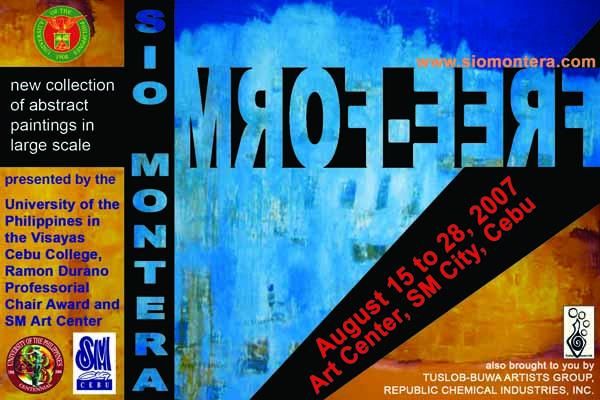
Alas Cuatro
Bluewater Gallery, Maribago Bluewater Beach Resort
“ALAS CUATRO @ Bluewater Gallery”
“Alas Cuatro” is an art exhibition by “Tuslob-Buwa”, an art group composed of four contemporary visual artists in Cebu namely Jojo Sagayno, Evan Bejec, Sio Montera, and Ritchie Quijano. The show highlights the four individual directions each have taken hence the title “Alas Cuatro”.
The exhibit takes significance because the group’s composition and the number signify solidity in structure. In a deck of cards, there can be only four aces and nothing more therefore “Tuslob-Buwa” as a group is complete.
The four are in the prime of their artistic professions. Jojo Sagayno is a progressive mixed-media conceptual artist and currently a member of the faculty of the College of Architecture and Fine Arts at the University of San Carlos in the Philippines. Evan Bejec was educated in the Fine Arts and is both a dedicated painter and prolific wood sculptor. He also teaches Basic Drawing at SM City Cebu’s Summer Art School annually. Sio Montera is an inexhaustible abstract expressionist painter and has mounted numerous solo shows to his credit. He completed his MFA at UP Diliman and is presently an Assistant Professor in the Fine Arts program of the University of the Philippines Cebu College. Lastly, Ritchie Quijano pursues the craft of both painting and sculpture. Extremely passionate in the field of art, Ritchie currently writes for Sun Star Daily covering the arts and culture scene of Cebu City.
The quadro of four emerging artists are set to unveil their most recent works at the Bluewater Gallery of Maribago Bluewater Beach Resort form January 19, 2006 to February 18, 2006.
The Bluewater Gallery is located in Maribago Bluewater Beach Resort in Mactan Island, Cebu, Philippines and is open from 10AM to 6PM on weekdays and from 10AM to 8PM on weekends. Non-resort guests are requested to call Ms. Juliet Amazona at 492-1808 or 232-5411 and arrange for an exhibit viewing appointment. For inquiries, you can call the above numbers or email the gallery at .
Press release
abstracSIOn
Bluewater Gallery, Maribago Bluewater Beach Resort, Mactan Island, Cebu, Philippines
Abstrac|SIO|n at Bluewater Gallery
The Bluewater Gallery will present the exhibition Abstrac|SIO|n, artworks by leading Cebuano abstractionist painter Dennis ‘Sio’ Montera from October 20 through November 17.
Sio Montera continues to break new ground with this new collection of works employing thickly dissolved and overlapped layers of acrylic, oil, and asphalt that alternate between bright and muted tones. The distillations of color, texture, and form in these paintings are typical of the artist’s deeply felt emotions, inspired by actual experiences in his immediate environment. To appreciate the paintings, the complete collection must be viewed as a whole; they become visual scribbling in an incomplete diary, each element representing words and sentences in a larger visual narrative of the artist’s life and adventures.
In this body of works, modulations of color are stretched over infinite or calculated geometric space, encouraging us to examine closely, the tonal presence of partly covered hues and textures as they sit in delicate balance in both symmetrical and asymmetrical planes. Montera’s ability to conjure up a sense of calm over chaos in the visual organization of his elements has since become a concrete expression in his past exhibitions. The show marks the artist’s sixth solo exhibition and his second for this year.
The Bluewater Gallery is located in Maribago Bluewater Beach Resort in Mactan Island, Cebu and is open from 10AM to 6PM on weekdays and from 10AM to 8PM on weekends. Non-resort guests are requested to call Ms. Juliet Amazona at 492-1808 or 232-5411 and arrange for an exhibit viewing appointment. For inquiries, you can call the above numbers or email the gallery at

Love Theories
Art Center, SM City Cebu, North Reclamation Road, Cebu City, Philippines
“Love Theories” SM Art Center Cebu
February with all its clichés attached is the month of love and will always be a time for loving. And SM Art Center’s love offering will be a concept show on the art of loving by four local contemporary Cebuano artists. “Love Theories” by the artists group “Tuslob-Buwa” will showcase four individual experiences on love. The four aspects will dwell on love-lust, love-lists, love-lost, and love lasts.
Full-time artist Evan Bejec’s visual essay on love-list is a kind of New Year’s wish list. Here he makes a presentation on love that he wants to happen including his aspirations on what love means to him. His listings are personal ideals in the concrete form of both painting and sculpture.
Tackling of a love that’s lost, abstract expressionist artist and U.P. Fine Arts professor Dennis ‘Sio’ Montera will provide a visual teaching instruction. These are thoughts and raw feelings represented by abstract ideas. Montera’s works are often in a conceptual form and non-figurative imagery depicted in multi-layered color field works. His works are profound appropriations of the artist’s emotions from losing a special someone.
Jojo Sagayno is a member of the USC Fine Arts faculty and is the only one married in the group hence as a family man with two kids explores the fulfillment of loving and being loved in return. Doing composite media works combined with painting as a signature in his art making he concentrates our family bound love for country and countrymen.
The lust for love is akin to lust for life and Ritchie Quijano believes that the ultimate purpose and reason for living is to love. Thereby as an artist he sees it as of paramount importance to express it in art. The heart being the universal symbol of love takes a prominent place in the series of artworks he made.
Full of personal symbolisms “Love Theories” is a highly autobiographical sketch on love-related experiences each of the four artists underwent. “Love Theories” is the second major exhibition to start the year by the “Tuslob-Buwa” Artists Group and will be unveiled at the SM Art Center starting on February 2, 2007 and to last until the whole world celebrates Valentines Day.

Press release
“Alas Cuatro” is an art exhibition by “Tuslob-Buwa”, an art group composed of four contemporary visual artists in Cebu namely Jojo Sagayno, Evan Bejec, Sio Montera, and Ritchie Quijano. The show highlights the four individual directions each have taken hence the title “Alas Cuatro”.
The exhibit takes significance because the group’s composition and the number signify solidity in structure. In a deck of cards, there can be only four aces and nothing more therefore “Tuslob-Buwa” as a group is complete.
The four are in the prime of their artistic professions. Jojo Sagayno is a progressive mixed-media conceptual artist and currently a member of the faculty of the College of Architecture and Fine Arts at the University of San Carlos in the Philippines. Evan Bejec was educated in the Fine Arts and is both a dedicated painter and prolific wood sculptor. He also teaches Basic Drawing at SM City Cebu’s Summer Art School annually. Sio Montera is an inexhaustible abstract expressionist painter and has mounted numerous solo shows to his credit. He completed his MFA at UP Diliman and is presently an Assistant Professor in the Fine Arts program of the University of the Philippines Cebu College. Lastly, Ritchie Quijano pursues the craft of both painting and sculpture. Extremely passionate in the field of art, Ritchie currently writes for Sun Star Daily covering the arts and culture scene of Cebu City.
The quadro of four emerging artists are set to unveil their most recent works at the Bluewater Gallery of Maribago Bluewater Beach Resort form January 19, 2006 to February 18, 2006.
The Bluewater Gallery is located in Maribago Bluewater Beach Resort in Mactan Island, Cebu, Philippines and is open from 10AM to 6PM on weekdays and from 10AM to 8PM on weekends. Non-resort guests are requested to call Ms. Juliet Amazona at 492-1808 or 232-5411 and arrange for an exhibit viewing appointment. For inquiries, you can call the above numbers or email the gallery at .
The cause of modernism by Raymund Fernandez, Cebu Daily News 08/29/2007
Showing now at the SM Art Center is Dennis “Sio” Montera’s one-person show of paintings, entitled “Free Forms.” Featured here are formalist, abstract paintings, which are in a way unprecedented for their sizes and consistency of style.
Dennis is one among the younger generation faculty of UP Cebu College Fine Arts Program. He recently finished his Masters of Fine Arts degree at UP Diliman. Prior to his undergraduate studies at UP Cebu, he trained under such artists as Mar Vidal. He is acquainted with the painting techniques of the local realists and once painted using the color principles taught by the late Cebuano master Martino Abellana, which he learned from the master’s students.
Most of his early naturalistic works orbited around the phenomenon of food. This was a natural consequence traced to his fondness for travel, especially to beach resorts. He takes his students regularly for painting sessions on the beaches of Bantayan Island. For these sorties he would often be accompanied by his barkada of artists, now organized into the art group Tuslob Buwa Ltd. The group holds regular summer art workshops at SM, as well as regular group shows done usually around a theme. Jojo Sagayno, one of the members of this group and currently teaching at the Fine Arts Department of University of San Carlos, spoke of a regular activity they hold on New Year’s Eve: they would go around the downtown area giving food to the people living on the streets.
Given this orientation, it is only expected that the group should espouse some higher cause. This cause is the cause of modernism and, being the young artists that they are, the cause of modernism is for them the battle cry for change. This, of course, is an assertion that cannot help but raise discussion and argument, especially that sort of argument that Western modernists had traditionally tried to escape from. Jackson Pollock, who was the great icon of Western modernism, had always stayed away from spoken and written discourses. He had the art critic and staunch supporter Clement Greenberg to do all the talking for him.
One might argue if modernism really represents any change at all, even in our locality. Abellana, after all, had done non-objective abstractionist paintings, some dated in the early sixties. On the other hand, there is already an established tradition of non-objective art making here. We have abstractionists like Tito Cuevas, Andrew Barba, Vidal Alcoseba, etc., who have worked in this genre for many years now. But it is true that the local audience for art is still stuck up with a type of naturalistic realism, most likely rooted to the feudalistic agricultural system, which still persists. Thus, clearly, the battle for modern art is yet to be won in the local setting.
I am not an abstractionist. My affinity is for post-modernism rather than for what has by now become mainstream, modernist art in the Philippine setting. Even so, I do have a lot of sympathy for any effort whatsoever to enhance modernism in our local community and country. Thus, I am inclined to give the local modernists my full measure of support. This is the reason why I feel they should increase the effort to clarify the philosophical basis of their art, especially in the literature that accompanies the work.
The paintings are by themselves exceptional but they are not themselves capable of artistic revolution. What modernists should do is to clarify, hopefully in vivid terms, their context in the local culture. We know the appearance of the works they like to produce. But because we are not a Western culture nor are we a fully westernized one, we cannot help but ask: What do modernists want for us? What do they envision for us in the future world? How should we view their works?
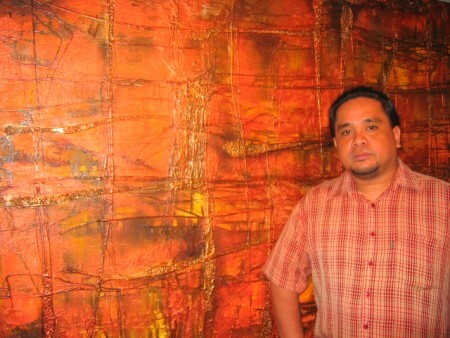
'Artpostles' exhibit review on Art Diocese by Roy Lu published in Cebu Daily News Oct.31,2007
In religion, humility is among the most desired of virtues. In art, it is audacity. Audacity is not the same as pride though it is often mistaken for such, making it appear like the antithesis of humility.
In "Art Diocese : Why Art Thou?," a show on-going at the SM Art Center, SM City Cebu, and up until November 6, audacity is as palpable as their subject is as deeply entrenched culturally if not spiritually amongst us.
There is humility, too, it should be said immediately, though this is more deferential as can be expected of confessed faithful members of the flock ("the exhibit is not intended to make a pun to the authority of the archdiocese"), yet cannot be any more than that as expected from artists whose gospel, contained in the exhibit statement (from where the above quote is also taken), proclaims at " . . . revisioning to a point where the artists investigated its old traditions to come up with conceptual forms attuned to post-modern times."
The Tuslob-Buwa Ltd. (though it should more properly be UnLtd.) Artists Group, composed of Evan Bejec, Dennis 'Sio' Montera, Ritchie Quijano and Lucilo 'Jojo' Sagayno have put together a show that, in all humility, they call a 'major' show, their last for this year, but for all its audacity should be seen as the best show for this year. Even in many years so far. And not only for their group, but for art in general in the city.
For one, more than in their previous two outings this year, this show exhibits an almost seamless cohesiveness that is nothing short of miraculous for a group of different or individual artistic temperaments, stylistic leanings and technical or conceptual proficiency.
This can be attributed largely to the fact that many of the pieces are collaborative works, which could really be the strength of groups though it could just as well be the cause of schism, as with many unfortunate cases. Here, thankfully, it is most of the former and, evidently, none of the latter.
On this score, "Santisima Nombre de Jesus," a large scale wall installation made of rattan skin and abaca rope that dominates the wall opposite the entrance, is an immediate case in point.
Together with the the life-size reinforcing steel bar, wood and assorted images crucifix of Ritchie Quijano ("Crucifixion de Kabilya") that stands very imposingly in the middle of the wall and divides the wall installation into a very dynamic symmetry, this sculptures-cum-installation recall the triumphal entrance of Jesus into Jerusalem on Palm Sunday that ends many days later in Golgotha.
These are by no means the cute and handy palm fronds peddled outside churches on Palm Sunday. They are huge bunches of clearly organic material whose chaos is barely restrained by a wound abaca rope giving it a quality that strongly strikes one as sinisterly chaotic grace.
Going back to Quijano's crucifix, this work is the pivot of the entire exhibit both spatially and thematically. Quijano's choice of material feeds very well into the conflicts or weights of the broken Christ; strength and weakness, grace and rigidness, salvation and despair, mortality and immortality and, for the church herself; orthodoxy and heterodoxy. This, then, also contributes to its very striking visual impact.
Towards the right wall (or towards the left from the entrance) are the installations of Jojo Sagayno that, I confess, I find most interesting. These works stamp the group with a seriousness of purpose beyond the traffic of the buying and selling of art -- which, I should also immediately confess, I do not find inherently objectionable -- even if, or ironically since it was Jojo himself who made an impassioned plea to the audience during the exhibit opening, that they should "buy an artwork before you die."
These works also confirm Sagayno's place as one of Cebu's most thought provoking if self-deprecating conceptual/installation artist.
Playing on the 'cross and sword'' dynamic of the Spanish conquest, Sagayno starts from the most literal imagery of nothing more than a cross and a sword. But its simplicity ends here though the fact that it continues be a disarmingly simple pieces is its poetic coup de grace.
For both pieces, the shapes are formed by sticks. For the cross, they are longer sticks: broomsticks. For the sword, they are shorter sticks: toothpick like. For both, the sticks are held in place by mounting gum, or, perhaps, playdoh.
They look fragile. They are fragile. But, collectively they are big. The cross must be around four meters by three. The sword about 3 meters in length from the end of the handle to the tip of the blade.
The cross-sticks is laid on the ground. The sword-sticks is on the wall overlooking (overseeing?) the cross. A subtle but very ingenious way to present the power relations between two institutions that underpinned the realpolitik of conquest.
Also, another thing. the cross is a positive image, though more a thick outline than a filled up object, while the sword is a negative one with the sticks radiating away from the edges that make up the figure.
But, here is the kicker: the sticks are tethered very tentatively on their mounting gum anchors. Already at the exhibit opening some of the sword-sticks have started to fall and some of the cross-sticks had started to topple down.
No power is permanent. Even, God forbid, that of the cross. Nor of the sword that propped it up.
But then, and here is an even bigger kicker; doesn't this run neatly into the there/not there paradox? Doesn't absence often become a greater presence? Ask someone in love who has lost a love.
I discussed this with Sagayno and he smiled. That's how it's supposed to be, he says. Nice.
Then there is another Sagayno, "Auction No. 1 to No.20 On the face of it, it looks out of place. But upon closer inspection the wickedly inventive art of Sagayno shines through.
With this work, Sagayno turns some tables. He shifts the spotlight. It is now on art or the art practice at the rarefied air of international art auctions (Christie's, Sotheby's) which, if art were a religion, these would be akin to the celebration of mass in a cathedral, or at the Sistine Chapel even. This is definitely Papal level, no disrespect to the Pope.
Pronouncements here are Ex Cathedra. And, what would those pronouncements be? They would be pronouncements of the auction gavel closing a sale. Contained within the reproductions of auctioned art works are their selling or closing prices.
The prices range from US$66,000 to US$ 3.99 M. Why an artwork in black with the text Mar. 31, 1975 in white sold for US$316,000 is simply a mystery as deep as the mystery of the trinity. Again, no disrespect to the triune God.
Then, there more notable collaborative pieces found on the left hand side of the space (or right side from the entrance). "Council of Trent," a collaborative work repositions that conclave, between 1545-1563, signaling the beginning of the Counter-Reformation is on a chess board, with personalities who might not have any actual correspondence in actual history, as the pieces.
Next to the chess table is the work, "Peticiones de Kwitis." This is the usual candle rack near churches where the faithful light candles or the candle vendor does the chore for them. Lighting candles assist the ascent of prayers to Heaven.
But, here, instead of candles, the rack is filled up with fireworks rockets, complete with their bamboo stick stabilizers.
On the visual level, they look like a petal-less, flame-less bouquet. On the content level, it is a tongue-in-cheek suggestion at how those prayers might be better assisted with rockets such as these that zoom to the heavens and explode with a noise that will surely wake up the sleepiest of saints, or otherwise, scare the most cantankerous of devils.
Then there are the smaller pieces, too numerous to enumerate here. They are the ones that Sagayno's earlier appeal would make sense with, for those of us who have less than deep pockets.
Still, this show is not about deep pockets, notwithstanding Sagayno's appeal. This exhibit is about the deep repository of poetics even folksy hermeneutics that will surely resonate with the faithful, the not so faithful and even the faithless.
In this way, even with some minor distracting pieces, the exhibit can be said to be faithfully Catholic.

Faith in Art by Ritchie Quijano
THE local art scene will be shaken anew from shock value when the group of four artists, known as Tuslob-Buwa Ltd., will present another unprecedented leap to where art hasn’t gone before.
The group is composed of Evan Bejec, Sio Montera, Jojo Sagayno and this writer. The collaborative show of paintings, installations and sculptures is titled Art Diocese.
It will try to reinforce faith by strengthening the visual form of articles and facts relevant to religion.
Opening reception will be at 6 p.m. on Oct. 24 at the SM Art Center.
The concept-themed show tackles the issue of continuity in the visual arts of the church and faith in the face of modernism and contemporary art. The church as an institution of faith will see a change of form and design as it enters a new era. The changes that are happening challenged the artists to contribute new and dynamic ideas.
To do this, they use elements of church and articles of faith to the body of knowledge known as visual arts history.
The substance of the exhibit will carry varied propositions in design concept. The group believes an artist is spiritual, and art to him is imbued with spirituality.
Art Diocese is intended as an adoration of faith, a revelation the artists will share with viewers. Most importantly, it is an epiphany that makes spirituality part of work attitude and the intellectual process. Such is the gospel according to Tuslob-Buwa.
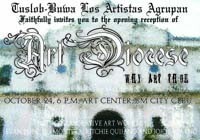
Freedom through Free-Form by Ardelle Merton
By Ardelle T. Merton
The Freeman Daily
Sunday, August 26, 2007
“In art perhaps, the creation of the free form epitomizes the greatest of all human rights of expression…Pure and honest abstraction is the pinnacle of the art practice because there are no visual guides, no preliminary studies, no references and the like…It is unpredictable in the sense that the artists can never foresee his desired result but given the free rein of his imagination, the artist exercises complete and unrestrained freedom,” scribed writer Ritchie Quijano in admiration of renowned local artist Dennis “Sio” E. Montera’s seventh exhibit solo exhibit.
Montera’s Free-Form is the artist’s new collection of large scale artworks symbolizing not only the creative freedom Quijano wrote of, but also of Montera’s personal growth as an artist. No longer contented with the standard canvass size, Montera went beyond conventional borders and created post-modernist abstractions on canvasses of larger scale. Thus, his Free-Form collection was born. His works feature layers of acrylic and mixed media to reach a captivating blend of colors that is uniquely Montera. Step into The Dark Side, and witness how spattering of wine-red and black can be so alluring. Pay Homage to Emil Schumacher, and marvel at how the otherwise bland color of gray could add much depth to a visual. The artist’s Four Sided Six will have you counting sides and shapes, and loving numbers in abstract form. At the grand size of 213 x 365 cm, his Composition in Grid-Stratum inspires one to indeed think big!
Cebuano artist Sio Montera was born in August 19, 1972. He earned a Bachelor of Fine Arts degree from the University of the Philippines (UP) Visayas-Cebu in 1996 and proceeded to earning a Master’s degree in Fine Arts from the UP Diliman College of Fine Arts in October 2004. He is currently an Assistant Professor in UP Visayas – Cebu as well as a Program Coordinator in the Fine Arts program. As a professor, he delightfully merges art theory and hands-on practice when teaching his college students. Sio Montera has carved his name in the local art scene through numerous solo and group exhibits throughout his artistic career.
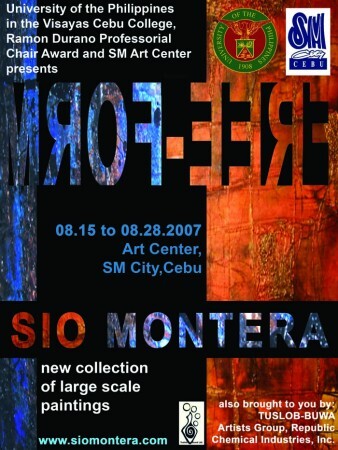
Sio Montera unveils latest works in FREE-FORM
Cebuano abstractionist painter Sio Montera will unveil his latest creations through the solo-exhibit “Free-Form” at the Art Center of SM City Cebu from August 15-28, 2007. The all-new collection of contemporary abstract paintings is part of the artist’s creative output as a recipient of the Ramon Durano professorial chair award from the University of the Philippines.
In this exhibit, Montera addresses the issue of ‘form’ in relation to the artist’s creative techniques and use of material. The artist believes that it is essential to dissociate the process of image-making from any pre-conceived idea, and to let form emerge out from the painting process itself. Thus, the act of painting would become a meditative event that would, in turn, lead to self-discovery.
With this latest exposition, Sio Montera confronts us with large format canvases that demonstrate both simple and complex configurations of paint masses, expressive force of texture, and color modulations characterized by a careful balance between spontaneous gesture and continual control. To lend order in every composition, the artist approaches each canvas from every side forming either atmospheric expanse or calligraphic grids that suggest an infinite extent, as if the pictorial space were merely a section chosen at random. As in all of Sio Montera’s abstractions, the elements are delicately worked up in alternating sequences with great force and rapidity to free form from pictorial illusion and achieve a post-painterly equilibrium in art.
FREE-FORM the exhibit is open to the general public from 10AM to 9PM daily. The Art Center is located at the 2nd level of SM City Cebu (beside VECO). For inquiries and appointments call 2319851 or 09173295626.

Free Form in Art
The issue of ‘form’ in relation to a predetermined appearance and meaning is being addressed by this artist. He believes that it is essential to dissociate the process of image-making from any pre-conceived idea, and to let form and content emerge out from the painting process itself. Thus, the act of painting would become a direct phenomenon that would, in turn, lead to self-discovery. This ‘directness in painting’ as motivated by the dictates of the artist’s passion, medium and technique, would allow the content to finally emerge.
The artist in his own way would build an open compostion, every detail of which is layered with equal intensity. An over-all field or total mass image may have no single object or shape that stands out from the total energy impact. In his process, the artist desires for ‘total-involvement’ with the act of painting. The works’ often comprise slabs of color and painterly marks that are impulsive and dynamic, and that seem to expand beyond the framing edges, as if the pictorial space were merely a section chosen at random. In this process, the artist now regards painting as an intense, unpremeditated search for the images of his creative experiences and/or emotions.
As in most of the artist's abstractions, the collection on this site are highly artistic configurations of paint masses, expressive force of texture, and color modulations characterized by a careful balance between spontaneous gesture and continual control. Having spurned conceptual design that leads to picture-making, the elements are delicately worked up from the bottom-up and from the top-down with a sense of immediacy to free form from pretty pictorial illusionism and attain a post-painterly equilibrium in art.
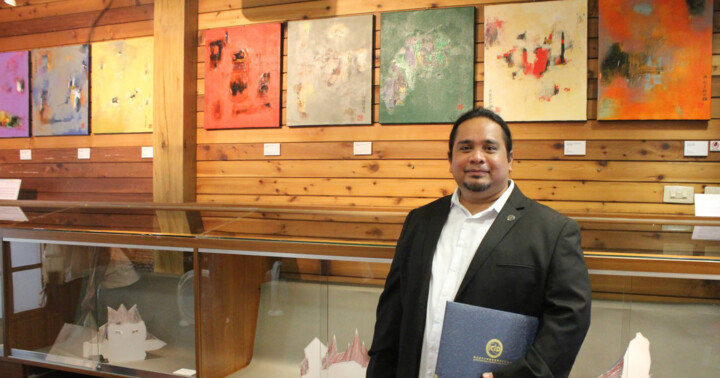
FREE-WILLING by Ritchie Quijano published in SunStar Daily August 21, 2007
WITHOUT freedom, no good work can be done.
In art, the creation of free form epitomizes the greatest of all human rights of expression.
When the mind takes over what the eyes can no longer perceive during artistic production, the aftermath will only be pure abstraction. Having to think in abstract terms can deter the self from reality and things practical because, first and foremost, abstraction exists only in the mind. Pure and honest abstraction is the pinnacle of the art practice because here the artist starts with zero visibility in the form of an empty space or a blank canvas.
It is unpredictable, in the sense that the artist can never foresee his desired result. Given a free rein of his imagination, the artist exercises complete unrestrained freedom.
Free Form, the seventh solo exhibition of Sio Montera, may be viewed at the SM Art Center till Aug. 28. This next level of his art brings him to the state of mind where the cerebral authority rules over “art.” An awakening of the artist’s subliminal self. Conscious all throughout in what he is doing, while freeing himself at the same time from representations that limit visual perception. Having the gift of free will has been innate in mankind since primordial times.
We inherit this capacity from birth, but rarely do we summon and use this power because of the fear to use it excessively. A new way of seeing and doing a painting may alter accepted customs and violates cultural restraints.
Montera, as an artist, wants big changes now. He wants to leave an imprint in art history by introducing new processes and new materials, like asphalt, which are alien to painting tradition. His mostly mixed media works are an amalgam of different paint mediums that overlap and blend with each other.
In some works, he employs outrageous implements such as a steel brush. He clearly is breaking rules. By exploring other painting grounds, such as tarpaulin, he paves the way to further exploration. In the vein of non-objective/abstract expressionism, Montera contributes to the movement’s endless possibilities. His continuous and spontaneous approach achieves what the mind can only perceive—the unseen and the unknown.
He farms a concept and plants the germ of an idea that blossoms into a wild but carefully controlled work of art worthy of a pedestal at the apex of artistic profession.

FLASH! FIFTEEN FILIPINO ABSTRACTIONISTS
SOCIETY has been exposed to the creation of abstract art since people have existed, but recognizably, there are varying "levels" of abstraction. Depending on the degree of abstraction, the artist has to discover more ingenious ways of conveying that precise concept. At an instance in humans’ early history, cave walls became the canvasses of men and women who drew scenes of hunting, of their flourishing bounty, of race, moment and milieu. Contemporary painters, such as Jackson Pollock, articulated emotions and pure concepts on canvas. Because his work has been inclined to focus around the notion of order within chaos, Pollock is an eminent paradigm. The perception of victory or success in hunting has to be easier to express than the notion of orderly chaos. With more involved "subjects", the form of expression itself has to become flexible. Thus, the significance of abstract art.
In his essay Roots of Diversity in Philippine Contemporary Art, artist/writer/curator Ronald Hilario noted that “The early 1950's saw the triumph of the modernists over the conservatives. Thanks to the efforts of Lyd Arguilla of the Philippine Art Gallery in showcasing the art of the young modernists, abstraction gained a stronger foothold and soon became the dominant style. More informed in the aesthetics of cubism, surrealism, and expressionism, these young artists expanded the concern of Philippine visual arts from style to a broader exploration of the formal elements of visual art. The first non-representational paintings and sculptures appeared at this stage, and were developed to a higher level by the third wave of artists who came in during the 1960's to the 1970's. Some of the more active artists in this period were Vicente Manansala, Napoleon Abueva, Jose Joya, Cesar Legaspi, Arturo Luz, and Fernando Zobel. Texts on abstract art became more available to artists in the 60's. Modernist art theories were introduced and taught in the Philippine Fine Arts Schools by academics and artists such as Rod Paras Perez and Roberto Chabet. Readings of these texts paved the way for a more cerebral approach to art making. Conceptual Art, Minimalism, and Performance Art made their debut in the country. Artists also became more vocal about their works and some published their ideas in art journals such the Philippine Supplement in the 70's. The Marcos regime's patronage of the arts added muscle to many artists' projects. The Cultural Center of the Philippines (CCP), the centerpiece of the First Lady Imelda Marcos' cultural program, was established and became the home of non-objective art. During the tenure of artist-curators Ray Albano and Roberto Chabet the CCP galleries were sites of numerous abstract art exhibitions and performances. At the forefront of these activities were Ray Albano, Gus Albor, Roberto Chabet, Mars Galang, Ben Maramag, Lee Aguinaldo and David Medalla.”
Modern art has usually been characterized by its inventiveness, and within this parameter, critics have looked to formal innovation to classify artworks in relation to their time, rather than place of origin. The nonrepresentational contemporary art that critics have made canonical was concerned with universal and transcendent aims, or with rendering concepts.
The title implies urgency, not the haphazard approach for art’s sake, but of the manner by which the artwork impacts on the viewer. It is the resultant realization when the message of the abstraction has been deciphered, and in this instant, that dawning comes charging fifteen times over. That ensuing speed, that consequential rush impinging on the cerebral, in a flash engulfs the aficionado.
This exhibition features paintings – significant pieces designed to visually expound important concepts about abstraction and its history in a non-threatening manner copulated with the dynamic relationship between discourses, forms, and styles. From the deceased to the emergent, the artists in this exhibition were all vital to producing the FLASH, a uniquely positioned showcase of Philippine Abstraction.
Ross Capili, Danilo Garcia, Andrew de Guzman, Fitz Herrera, Raul Isidro, Alfredo Liongoren, Sio Montera, J Elizalde Navarro, Eghai Roxas, Hermi Santo, Sherwin Tan, Roy Veneracion, Phililip Victor, Javy Villacin and Nestor Olarte Vinluan.
FLASH! Fifteen Filipino Abstractionists shall be on view starting October 18, 2008 at Galerie Anna, 7th floor, Ramon Magsaysay Center, Roxas Boulevard corner Dr. J. Quintos Street, Manila 1004 Philippines. For more information and queries about the gallery and the exhibition, you can log on to , contact Gallery Manager Mr. Joffrey Baylon at landline number (632) 5679483, or email at .
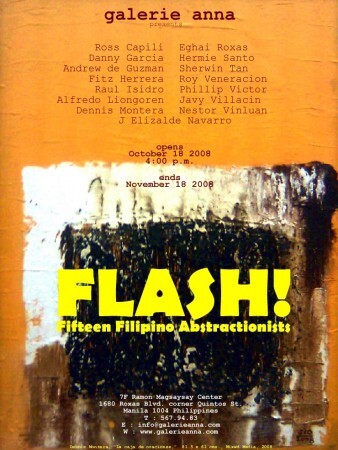
Ekzena @ Ricco Renzo Galleries
Ricco Renzo Galleries puts on view a three-person exhibit entitled “EKZENA” which opens on May 22, 2009. Revolving around the perception of “scenes,” the mind-set of Zen and the concepts of lyrical abstraction, the title has inference to a philosophy where art is presented in a style that combines maximum of technique and a minimum of planning and deliberation. However, the abstractions presented are not the haphazard approach for art’s sake, but of the manner by which the artwork impacts on the viewer.
Scenes are very much a part of everything that is art. A scene can be a subject or the content the artist will portray but it can also be the place and venue where an event takes place. To create and make a scene implies action and movement. This action of a scene is the very essence of the phenomenon of a happening. The occurrence of an art happening alludes to an improvised spontaneous art activity or exhibit where the eyes of an audience are treated to art that is free and unpredictable. Spontaneous abstract art can not be planned and predetermined. Pure and clean abstraction excites visual perception. Looking at an abstract painting oftentimes creates individualistic episodes depending on how the viewer views it. Abstraction is open to varied opinion and interpretations. It combines free will, intellect, intuition and instinct.
“EKZENA,” an abstract art exhibition by the triumvirate of artists namely JCrisanto Martinez, Sio Montera and Javy Villacin suggest all of the things and incidents mentioned above. Each artist presents a personal series of works that tackle chosen themes like time, space, the jouirney of life, death, wisdom, and the paradoxes of our human condition.
JCrisanto Martinez’s oeuvres reflect on “time” as a sinuous medium to be maneuvered similarly as paint. His washes of acrylics on burlap delve into the continuum of time. By layering images, Martinez incorporates undertones and meanings that summon a response by the viewer. At one end of the premise of his series’ working concept is to defy the notion of art as perceive merely by sight. Intuition – which is the state of knowing something instinctively, or the immediate knowledge of something – as a word and a process came as a challenge to the artist in developing this series.
Sio Montera’s mixed media explore on “free form.” These impasto art pieces bring him to the state of mind where the cerebral authority rules over “art;” an awakening of the artist’s subliminal self. As the outcomes are unpredictable, the artist is conscious all throughout in what he is doing, while freeing himself at the same time from representations that limit visual perception.
The large canvasses of Javy Villacin continue and deepen his foray into the dream world. The aggregate of works aptly about “shambala” which is a “higher level of consciousness and spirituality,” Villacin reinforces his fascination with this dream world that straddles many states of consciousness by focusing more on the emotional atmosphere and visual resonance. But the basic elements of a Villacin artwork are the usual pencil backgrounds that rejoice the reticence, the daring even, in some cases, the mayhem of drawing.
The three artists are highly individual players who have all made a niche in the arena of abstraction. Though a happening is a scene or an “ekzena” in the confines of a gallery it very much includes the creation of an overall feeling of a contained atmosphere in a walled environment. Abstractions can be a trip to an altered state and an environment in an alternate dimension. As products of potent minds, abstract art embraces all and everything the heart and mind can originally conceived and at the same time alienates impossibilities.
EKZENA will be on view at Ricco Renzo Galleries starting May 22, 2009 at 7pm with an opening cocktail. The exhibit runs until June 11, 2009. The Ricco Renzo Galleries is located at the LRI Design Plaza, 210 Nicanor Garcia St., Bel-Air II, Makati City, Philippines. For inquiry please call 898-2545 or 0927-386-1460, email or visit .

Reviews and comments


